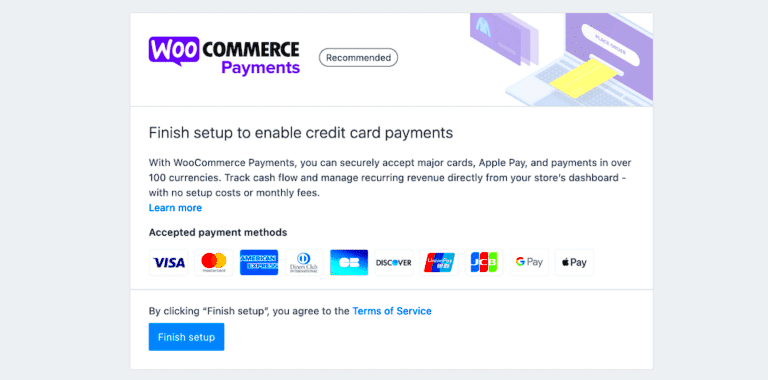Are you looking to streamline your online store’s payment process? WooCommerce Payments could be your answer! As a built-in payment solution for WooCommerce, it simplifies transactions directly within your WordPress site. This intuitive system is designed to cater to various payment types, ensuring both you and your customers have a seamless experience. So let’s dive into what
Benefits of Using WooCommerce Payments
When it comes to selecting a payment processor, WooCommerce Payments offers several advantages that can enhance your online store experience. Here are some key benefits:
- Seamless Integration: Since WooCommerce Payments is built specifically for WooCommerce, it integrates flawlessly with your existing store, allowing you to manage everything from one dashboard.
- Simple Setup: Getting started is easy! Just a few clicks are necessary, and you can start accepting payments in no time.
- Multiple Payment Methods: This service supports various payment options, including credit cards, debit cards, and more, catering to your customers’ preferences.
- Real-Time Reporting: WooCommerce Payments provides insights into your transactions, so you can monitor your sales and make informed business decisions.
- Secure Transactions: Customers will appreciate your commitment to security. Transactions are encrypted and protected, enhancing trust in your business.
- No Additional Fees: Unlike some third-party gateways, WooCommerce Payments doesn’t charge extra fees for using their service, which can ultimately save you money.
- Customer Support: You’ll have access to dedicated support, ensuring you get help whenever you need it to resolve issues swiftly.
With these benefits, it’s no wonder that many online retailers are choosing WooCommerce Payments to simplify their checkout process while providing an optimal experience for their customers!
3. Prerequisites for Setup
Before you dive into setting up WooCommerce Payments, there are a few essential prerequisites you’ll want to have in place. Having these items ready can streamline the setup process and ensure that everything runs smoothly. Here’s what you need:
- A WordPress Site: First and foremost, you need a WordPress website with the WooCommerce plugin installed and activated. This is the foundation of your online shop.
- Business Location: WooCommerce Payments is available in specific countries. Ensure your business location aligns with the availability of WooCommerce Payments.
- SSL Certificate: Security is crucial, especially when dealing with payment information. Make sure your site has an SSL certificate for secure transactions.
- Supported Currency: Verify that Woocommerce Payments supports the currency you plan to use for transactions. This can affect your international sales.
- Business Bank Account: You’ll need a bank account where your payments will be deposited. Ensure that it meets any requirements set by the WooCommerce Payments system.
- Identification Documents: Prepare a government-issued ID or any documents required for identity verification during the setup.
Having these prerequisites in order will not only make the setup process easier but also increase the security and functionality of your online store. By ensuring you have everything needed, you can focus on what truly matters—growing your business!
4. Step-by-Step Guide to Setting Up WooCommerce Payments
Once you’ve made sure all prerequisites are met, it’s time to get started with the setup process for WooCommerce Payments. Here’s a simple, step-by-step guide to help you get your payment processing up and running:
- Access the WooCommerce Settings: Log in to your WordPress dashboard and navigate to the WooCommerce section. Click on “Settings” and then head to the “Payments” tab.
- Enable WooCommerce Payments: In the Payments tab, you’ll see various payment options available. Find “WooCommerce Payments” and toggle the switch to enable it.
- Create a WooCommerce Payments Account: If this is your first time using WooCommerce Payments, you’ll be prompted to create an account. Follow the on-screen instructions, entering your details as requested.
- Provide Business Information: You’ll need to fill in your business information, such as name, address, and tax details. This information helps WooCommerce verify your account.
- Connect Your Bank Account: Enter your bank account details where payouts will be deposited. Double-check for accuracy to avoid any transaction issues.
- Verify Your Identity: Depending on your location, you may need to upload identification documents for verification. Take a moment to have the required documents handy.
- Set Up Payment Methods: Once your account is created, you can customize the payment methods that customers will see at checkout. Decide if you want to accept credit cards, debit cards, and other payment options.
- Test the Integration: Before going live, it’s a good idea to run a test transaction. This ensures everything works perfectly and gives you peace of mind!
And there you have it! Following these steps should have your WooCommerce Payments set up in no time. Remember, keeping customers happy means providing them with a smooth and secure checkout experience!
Configuring Payment Options
Setting up payment options in WooCommerce is a crucial step in ensuring that your online store operates smoothly and provides a seamless shopping experience for your customers. Here’s a straightforward guide to help you configure payment options effectively.
First, navigate to the WooCommerce settings from your WordPress dashboard. Click on the “Payments” tab to explore the various methods available. You’ll notice several options including:
- Credit Card payments: Accept payments directly on your site.
- PayPal: A popular choice for many users.
- Bank Transfer: An option for customers who prefer to pay manually.
- Cash on Delivery: Great for local businesses or certain situations.
- Stripe: Accepts credit cards, Apple Pay, Google Pay, and more.
After selecting your preferred payment methods, click on the “Set up” or “Manage” button next to each option to fill in the necessary details. For instance, if you choose PayPal, you’ll need your PayPal email address to link your account.
Moreover, ensure you enable the options that resonate with your audience. Consider regional preferences, as certain payment methods may be more popular in specific areas. You want to provide a range of options to accommodate diverse customer needs.
Lastly, don’t forget to save your changes! It may seem trivial, but saving your settings after each configuration can save you from potential headaches later on.
Testing Your Payment Setup
Now that you have configured your payment options, the next vital step is to ensure everything works seamlessly. Testing your payment setup might seem tedious, but it’s essential for providing a glitch-free shopping experience for your customers.
Here’s how to effectively test your payment setup:
- Enable Sandbox Mode: Most payment gateways, such as PayPal and Stripe, offer a sandbox mode for testing. This allows you to simulate transactions without processing real payments. You can find this option in the settings of each payment gateway.
- Conduct Test Transactions: Make test purchases using various payment methods. Use different user accounts, if necessary, to mimic how different customers might interact with your site.
- Check Email Notifications: Ensure that order confirmation emails are sent to both the customer and the admin. This is crucial for tracking sales and customer engagement.
- Review Ecommerce Reports: After conducting test transactions, look into your WooCommerce reports to check if the transactions reflect correctly.
- Item Availability: Make sure to verify that sold-out items are accurately reflected in the checkout process.
After thorough testing, remember to disable sandbox mode. Once you’re satisfied everything’s working as it should, you can go live, knowing your customers will have a secure, smooth, and reliable checkout process.
Best Practices for Using WooCommerce Payments
When it comes to using WooCommerce Payments, following some best practices can help streamline your transactions and improve customer satisfaction. Here are some key tips to keep in mind:
- Keep Your Software Updated: Regular updates ensure improved security and new features. Make sure both WordPress and WooCommerce are up to date.
- Use HTTPS: Always secure your website with an SSL certificate. This not only protects customer data but also builds trust.
- Set Up Address Verification: Enable AVS (Address Verification System) to reduce fraud. This adds an extra layer of security for online transactions.
- Monitor Transactions: Regularly check your transaction reports. Look out for unusual activity, which may indicate potential issues or fraud.
- Customize Payment Methods: Offer a variety of payment options to accommodate different customer preferences. This could include credit cards, Apple Pay, or even PayPal.
- Test Your Payment System: Before going live, run several test transactions to ensure everything functions smoothly. This helps catch potential problems early.
- Optimize for Mobile: Ensure that your payment process is mobile-friendly. More shoppers are using their smartphones; a smooth mobile experience is crucial.
Implementing these best practices can make using WooCommerce Payments a breeze for both you and your customers. Happy selling!
Common Issues and Troubleshooting
Even with the best setup, issues can arise when using WooCommerce Payments. Here, we’ll discuss some common problems and how to troubleshoot them effectively.
| Issue | Possible Cause | Solution |
|---|---|---|
| Transaction Declined | Insufficient funds or incorrect card details | Advise the customer to check their payment information and try again. |
| Payment Gateway is Down | Temporary service outage | Check WooCommerce status page and contact support if necessary. |
| Slow Processing Times | High server load or connectivity issues | Optimize your hosting environment and consider upgrading if necessary. |
| Inability to Issue Refunds | Account settings configuration | Ensure your account is set up to allow refunds and contact support for assistance. |
Remember, even the most reliable systems can encounter issues. By familiarizing yourself with these common problems and their solutions, you can maintain smooth operations and keep your customers happy.
Additional Resources and Support
When you’re diving into WooCommerce Payments, knowing where to find additional resources and support can make all the difference in your e-commerce journey. Thankfully, there is a plethora of options available to help you troubleshoot issues, stay updated, and even learn new strategies for growing your online store.
Here’s a breakdown of some key resources:
- WooCommerce Documentation: The official WooCommerce documentation is incredibly comprehensive. It covers everything from installation to advanced settings and troubleshooting. You can access it here.
- WooCommerce Support Forums: Engage with a community of fellow WooCommerce users and developers. The support forums are a great way to ask questions and share experiences. You can find it here.
- Online Courses and Webinars: Platforms like Udemy or LinkedIn Learning offer courses specifically focused on WooCommerce. These are fantastic if you’re looking for structured learning.
- Social Media Groups: Facebook and LinkedIn have dedicated groups where WooCommerce users share tips, tricks, and support. They can be a great source of inspiration and advice.
- Official WooCommerce Blog: Keep up with the latest updates, features, and best practices by following the official WooCommerce blog. It’s a goldmine for any store owner.
By utilizing these resources, you’ll not only enhance your understanding of WooCommerce Payments but also ensure your online store runs smoothly, benefiting your business in the long run.
Conclusion
Setting up and maximizing WooCommerce Payments for your online store can seem daunting at first, but with the right guidance, it transforms into a straightforward task. By following best practices—like ensuring your site is secure, optimizing for conversions, and utilizing the rich resources available—you set the stage for a successful e-commerce venture.
Remember, the key takeaway is not just about processing payments; it’s about enhancing customer experience and simplifying transactions. Happy customers lead to repeat customers, and this is what we aim for in e-commerce.
As you venture into the world of WooCommerce Payments, keep these points in mind:
- Invest time in understanding the features and benefits of WooCommerce Payments.
- Regularly update and monitor the performance of your payment system.
- Don’t hesitate to seek help from the community or professional services if you hit a roadblock.
In the end, the combination of well-informed decision-making and the effective use of available tools will empower you to create a thriving online store. So go ahead, implement what you’ve learned, and watch your e-commerce business flourish!



